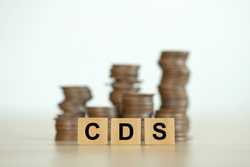- Guaranteed return based on the interest rate of the CD, an advantage if rates fall during the term of the CD
- FDIC insurance up to $250,000 per depositor, per financial institution
CD vs. Bonds: How Do They Compare?

Our evaluations and opinions are not influenced by our advertising relationships, but we may earn a commission from our partners’ links. This content is created by TIME Stamped, under TIME’s direction and produced in accordance with TIME’s editorial guidelines and overseen by TIME’s editorial staff. Learn more about it.
Certificates of deposit (CDs) and bonds are both popular investments. They’re generally considered safer than stocks because of their lower volatility and potential for regular cash payments. Despite their similarities, there are a few key differences that mean they fit very different roles in investors’ portfolios.
A CD is very similar to a savings account. They’re typically offered by banks and credit unions. You open a CD like any other bank account, make your deposit, and accrue interest over time. CDs are also eligible for Federal Deposit Insurance Corporation (FDIC) insurance like other deposit accounts.
What sets CDs apart from savings accounts is that they have a specific maturity date. When you open the CD, you promise that you won’t withdraw any of the money until the maturity date arrives. If you do need to make an early withdrawal, you’ll have to pay a penalty.
In exchange for this reduced flexibility, CDs often pay higher interest rates than savings accounts.
When you open a CD, you make money through the interest payments that you receive. Typically, the bank adds the accrued interest to the balance of the CD, so you get access to the interest once the CD matures. In some cases, you may be able to have the bank pay the interest to an external account so you can use it right away, though that’s rarer.
A bond is a security issued by an organization that wants to borrow money. Entities such as local or national governments, corporations, and government agencies can sell bonds to raise money for various purposes.
The organization that borrows money by selling bonds promises to pay back its creditors. Most bonds come with a face value, which is the amount that the initial purchaser paid for it, an interest rate (sometimes called coupon rate), and a term.
Unlike CDs, most bonds can be traded by investors after they’re issued. Some U.S. government savings bonds, such as EE bonds and I bonds are the exception, but they can be redeemed before their maturity date in many cases.
Bonds that investors can trade are called marketable bonds. With marketable bonds, you can sell the bond to get money back even before the bond matures. The value of the bond will depend on its face value and the current interest rate market. Generally, when market rates rise, bond values fall. When market rates fall, bond values rise.
Investors primarily make money from the interest payments that bonds offer. The bond issuer makes interest payments, usually twice per year, based on the interest rate. For savings bonds, interest is added to the bond’s value and can’t be accessed until the bond is redeemed. For marketable bonds, interest payments are made in cash and the investor can use the funds immediately.
Once the bond’s term ends, the investor holding the bond receives a final interest payment as well as the return of the bond’s face value.
For example, if you own a $1,000 bond with a 6% interest rate you’ll get two payments of $30 each year. Once the bond matures, you’ll get a final $30 payment and your initial $1,000 back.
Sometimes, investors can make money by selling a bond for a profit. For example, imagine you pay $1,000 for a bond that has a 5% interest rate. Since then, market rates have fallen and similar bonds now have an interest rate of 4%. Your bond will be worth more because of its higher interest rate, meaning you could sell it for more than the $1,000 you paid for it.
After selling the bond, you’ll receive the proceeds from the sale but stop receiving interest payments.
| CD | Bonds |
|---|---|
Similar to a bank account | Securities sold by governments and corporations |
Pay interest based on account balance | Pay interest based on the bond’s face value |
Interest is often added to the account balance, so it can’t be used immediately | Interest payments are immediately usable |
You pay a penalty if you withdraw money before the CD matures | You don’t have to pay a penalty if the bond is sold before it matures, though its value may have risen or dropped |
Terms usually range from a few months to five years | Terms can be as long as 30 years |
Balance is FDIC insured up to $250,000 per depositor, per financial institution | Bonds are not insured. You may lose money if the borrower defaults |
Typically, bonds pay more than CDs, though this is not always true. There are many different types of bonds; the returns offered will depend on the type of bond and the credit rating of the issuer. The higher the issuer’s credit rating, the lower the interest rate it can offer to attract investors.
The U.S.government is considered one of the safest bond issuers in the world. Public, an online investment company, lets investors earn up to 5.3% yield by investing in Treasuries, a type of U.S. government bond. By comparison, Valley Bank offers 4.75% annual percentage yield (APY) on its six-month CDs and 4.50% APY on its 12-month CDs.
Other U.S. government bonds, particularly long-term ones, are offering lower rates, with rates between 4.25% and 4.6% for bonds with maturities between five and 30 years.
Major corporations are seen as strong borrowers, but not quite as strong as the U.S. government. Top-rated corporate bonds pay about 5.40% interest as of early March 2024. Lower-rated, but still relatively safe, bonds pay 5.60%.
A CD is a good idea for people who want to save money for a few months to a few years. They’re ideal for specific goals, such as buying a new car or taking a vacation because you can set money aside for a set period of time and earn interest on the balance.
Bonds are designed for long-term investors. They’re a good idea for people who want a low-risk option for growing their portfolio over the course of years and decades. They’re also a good fit for investors who want to earn an income from their investment portfolio through the regular interest payments they offer.
$0 stock & ETF trades.
1.25% crypto fee.
$100 treasury bills.
CDs and bonds both give investors a way to earn interest on their money but serve very different purposes. CDs are bank accounts that offer higher interest rates in exchange for agreeing to keep your cash deposited for a set period. That makes them ideal for short-to-medium–term goals.
Bonds, on the other hand, are securities that you can typically trade on the open market. They offer long-term interest payments, so they’re ideal for investors looking for a lower-risk investment option or who want income from their portfolio.
Now may be a good time to buy bonds, especially if you believe interest rates will hold steady or drop in the future. The federal funds rate, a benchmark rate that influences rates for many products, including bonds, is at its highest point since 2007.
Laddering CDs means opening multiple CDs with staggered maturity dates. For example, if you open four CDs and set the maturities so that one matures every three months, you have the chance to take some money out of the CD ladder every three months. That offers more flexibility than opening a single CD but is slightly more complex. Still it can be a good idea if you want the security of being able to regularly access some of your CD savings in an emergency.
It is better for a CD to pay interest monthly than at maturity. The more frequently a CD pays interest, the greater the effect of compounding will be, increasing your overall returns.
The information presented here is created by TIME Stamped and overseen by TIME editorial staff. To learn more, see our About Us page.




